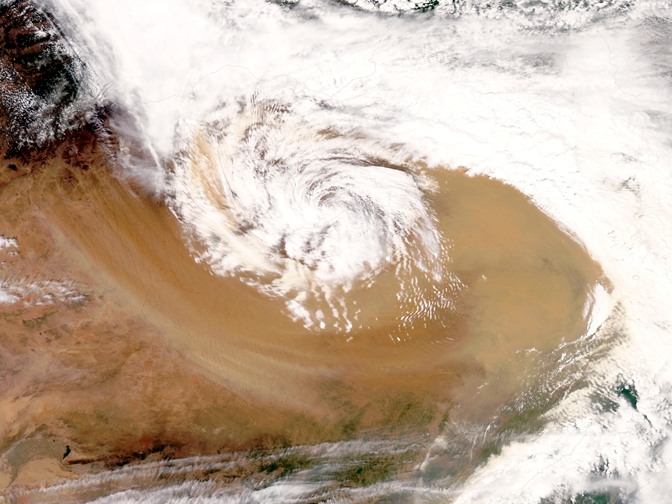

Two years after the conclusion of a formal Co-operation Agreement, ECMWF and the China Meteorological Administration (CMA) are extending their successful collaboration on satellite data to other fields, including the prediction of dust storms.
CMA hosts the Asian node of the Sand and Dust Storm Warning Advisory and Assessment System (SDS-WAS), an initiative sponsored by the World Meteorological Organization (WMO).
“Dust storms are a big problem in Asia, especially in spring. Dust events can affect air quality in Chinese cities and can travel as far as the Korean Peninsula and Japan,” says ECMWF scientist Angela Benedetti, who is a member of the SDS-WAS Steering Committee.
The idea is to combine dust forecasts from different models and to make the resulting multi-model products available to interested users. This effort is supported by the EU-funded, ECMWF-run Copernicus Atmosphere Monitoring Service (CAMS) as well as other international forecasting centres.
“Since CAMS runs global models, it can provide global forecasts to all SDS-WAS regional nodes, as it is already doing for the European node,” Dr Benedetti explains.
“We work together to help the Asia region provide a sand and dust storm service,” says Dr Bi Baogui, the Director-General of China’s National Meteorological Center (NMC), which is part of CMA.

Example of a CAMS dust forecast. The chart shows a 36-hour forecast of dust aerosol optical depth at a wavelength of 550 nm for 12 UTC on 6 January 2016 (courtesy of CAMS website).
SDS-WAS was set up in 2007. Three regional nodes have been created so far. They cover North Africa, the Middle East and Europe (NA-ME-E); Asia; and the Americas.
Satellite collaboration
Meanwhile, collaboration between ECMWF and CMA on satellite data has been deepening over the last few years.
In September 2014, ECMWF actively used Chinese satellite data for the first time in its operational forecasting system.
“We have had a succession of successful visits from CMA dedicated to satellites, and in turn some of our staff have spent time in Beijing,” says Stephen English, the Acting Head of ECMWF’s Data Division.

A five-strong CMA delegation led by Dr Bi Baogui (sixth from left) visited the Centre on 19 and 20 November 2015.
Jointly with the UK Met Office, ECMWF has been working with CMA to fully understand, and hence make effective use of, observations from China's FY3 polar-orbiting satellites. Initial collaboration focussed on instruments on the FY-3A and FY-3B research satellites, in preparation for the operational FY-3C satellite, which was launched in September 2013.
“It is very important to have strong lines of communication with data providers because it is very difficult for us to know which aspects of the calibration of the system might be generating something we see in the data and don’t understand,” Dr English says.
Dr Bi Baogui agrees that “bilateral collaboration is very good”. “We benefit a lot from ECMWF, including from its products and its technology.”
Top image: Dust storm over northern China on 27 May 2008 (Stocktrek Images/Thinkstock)
